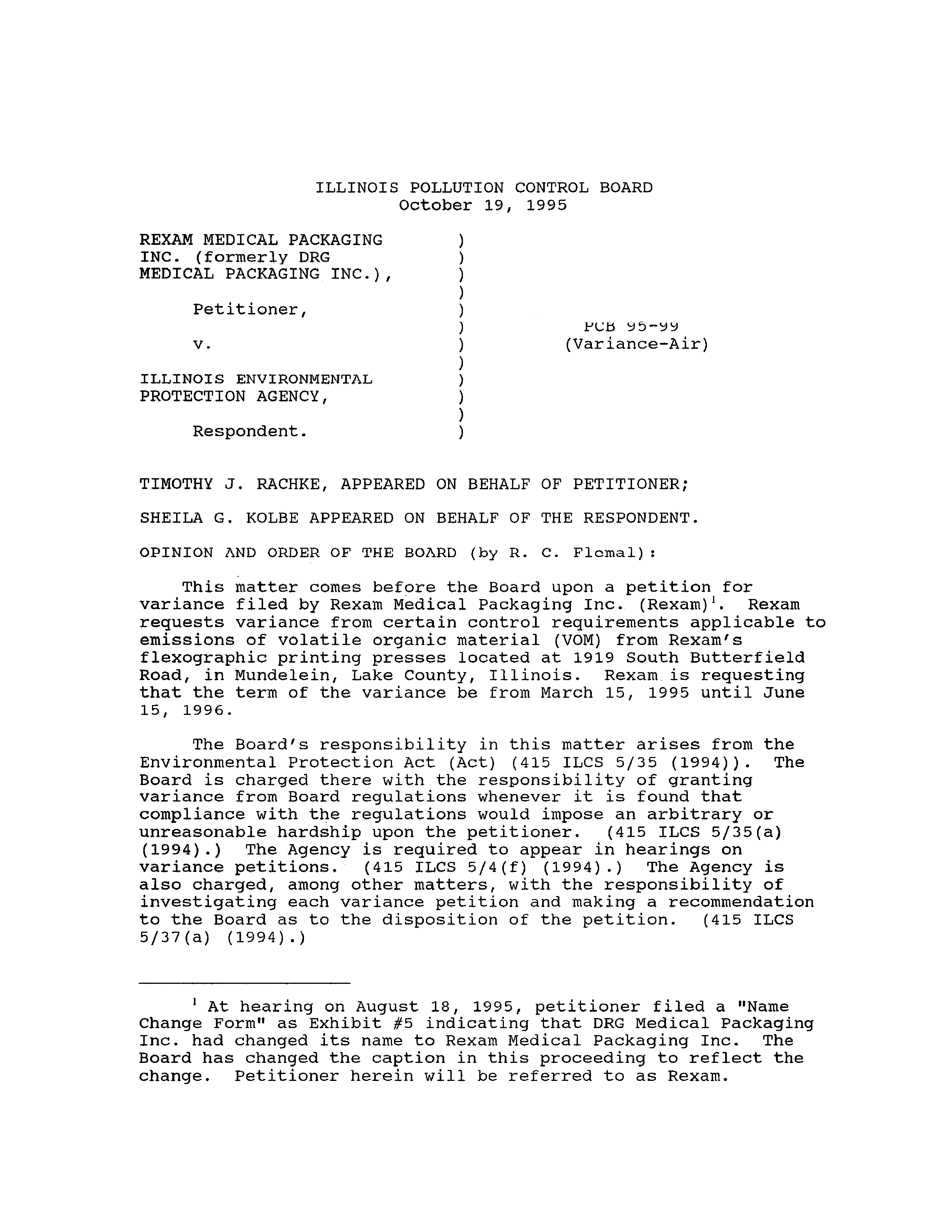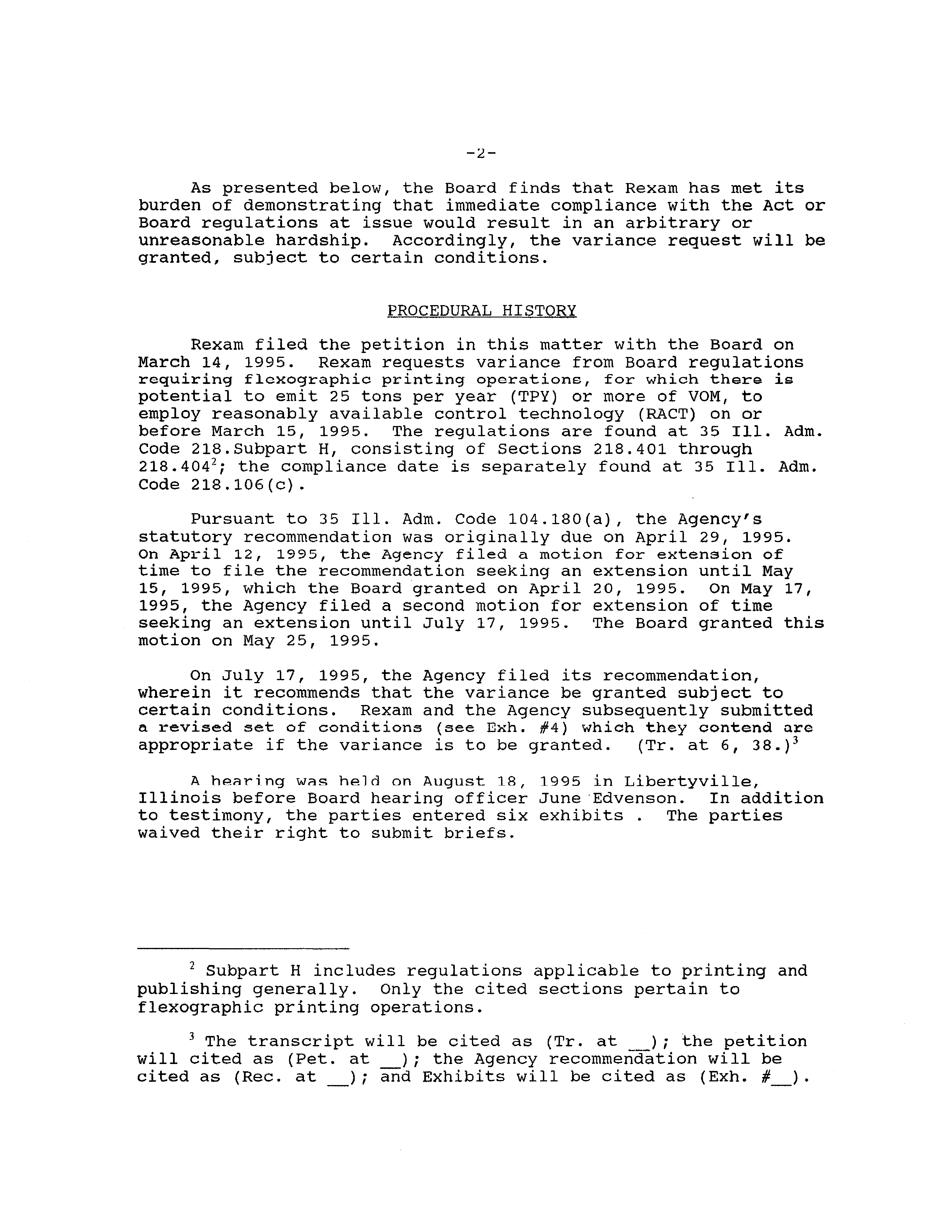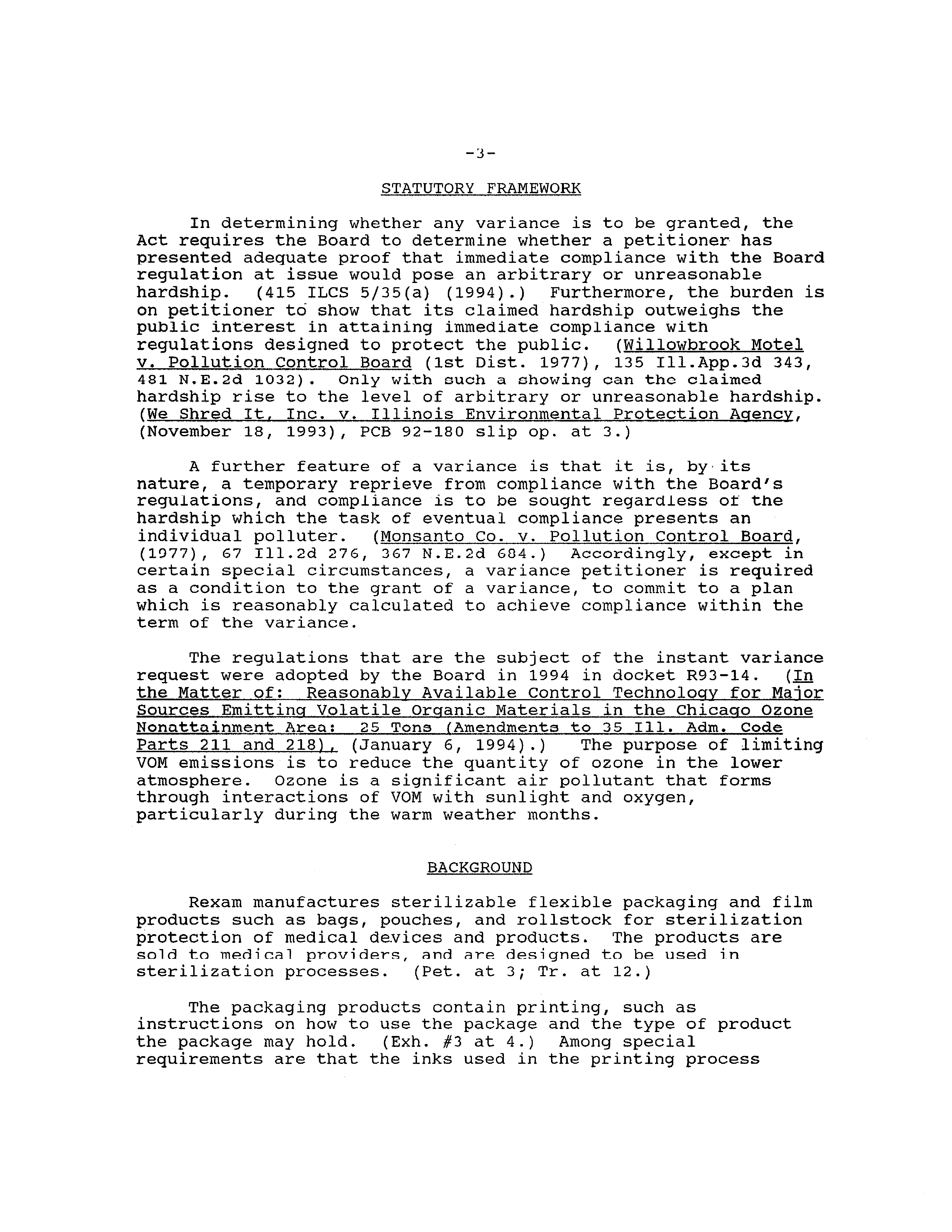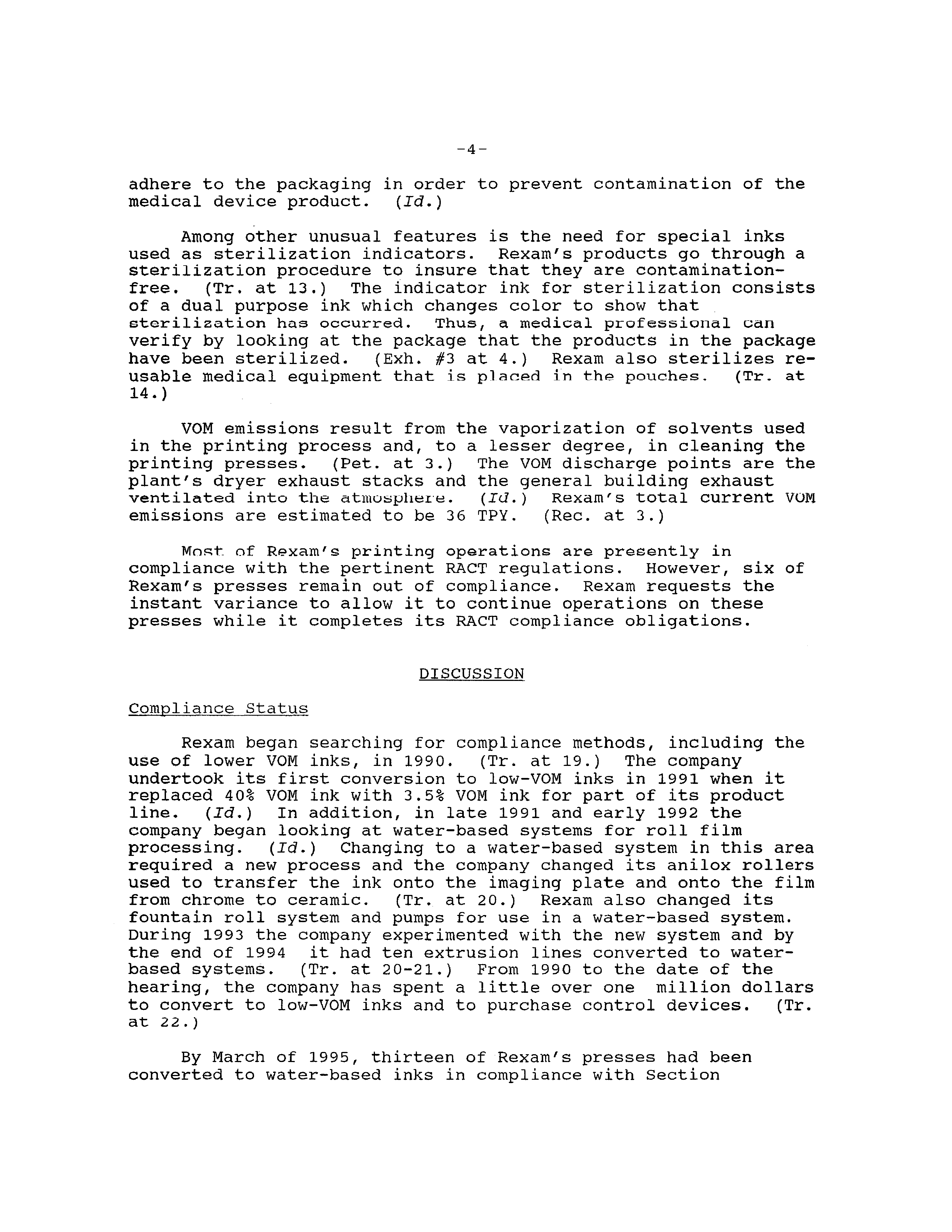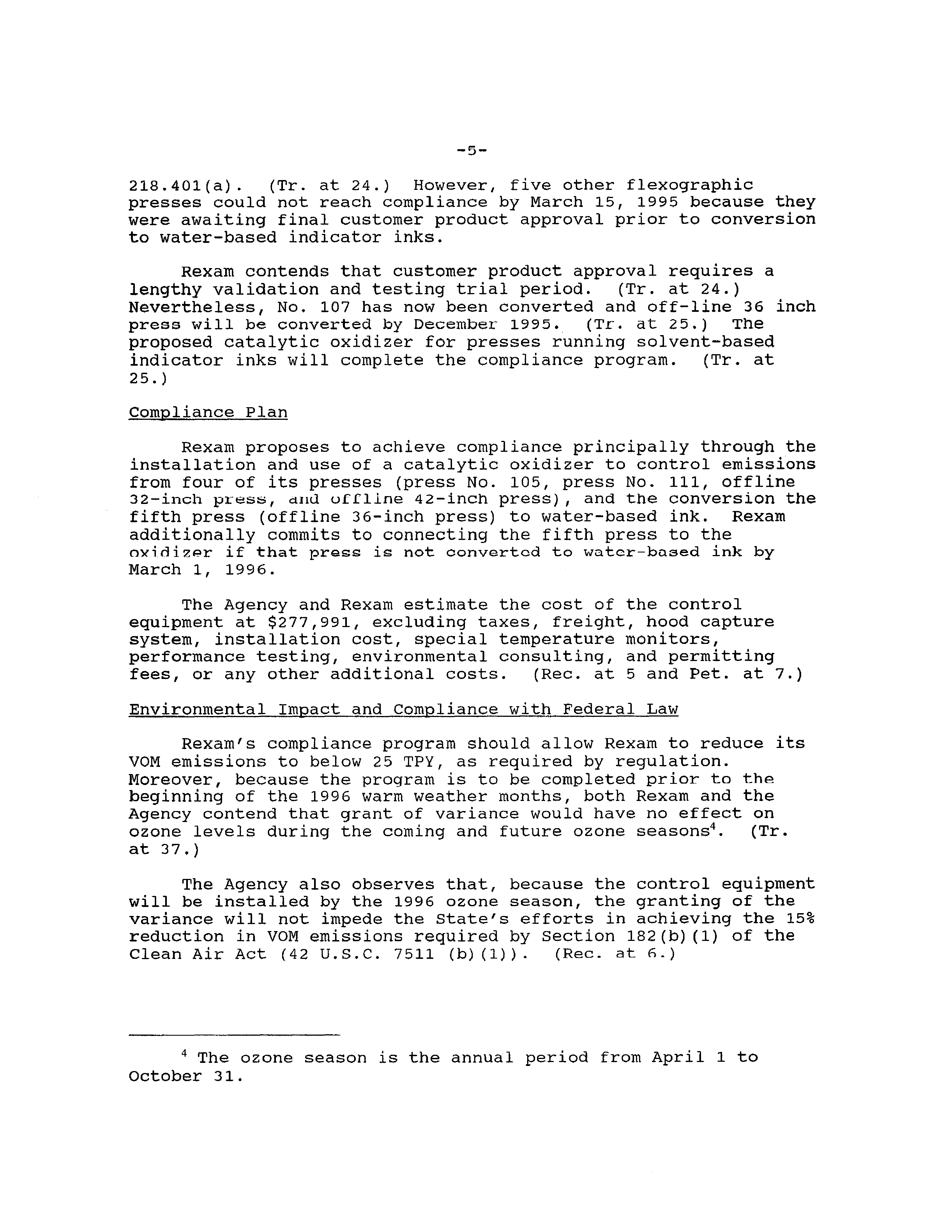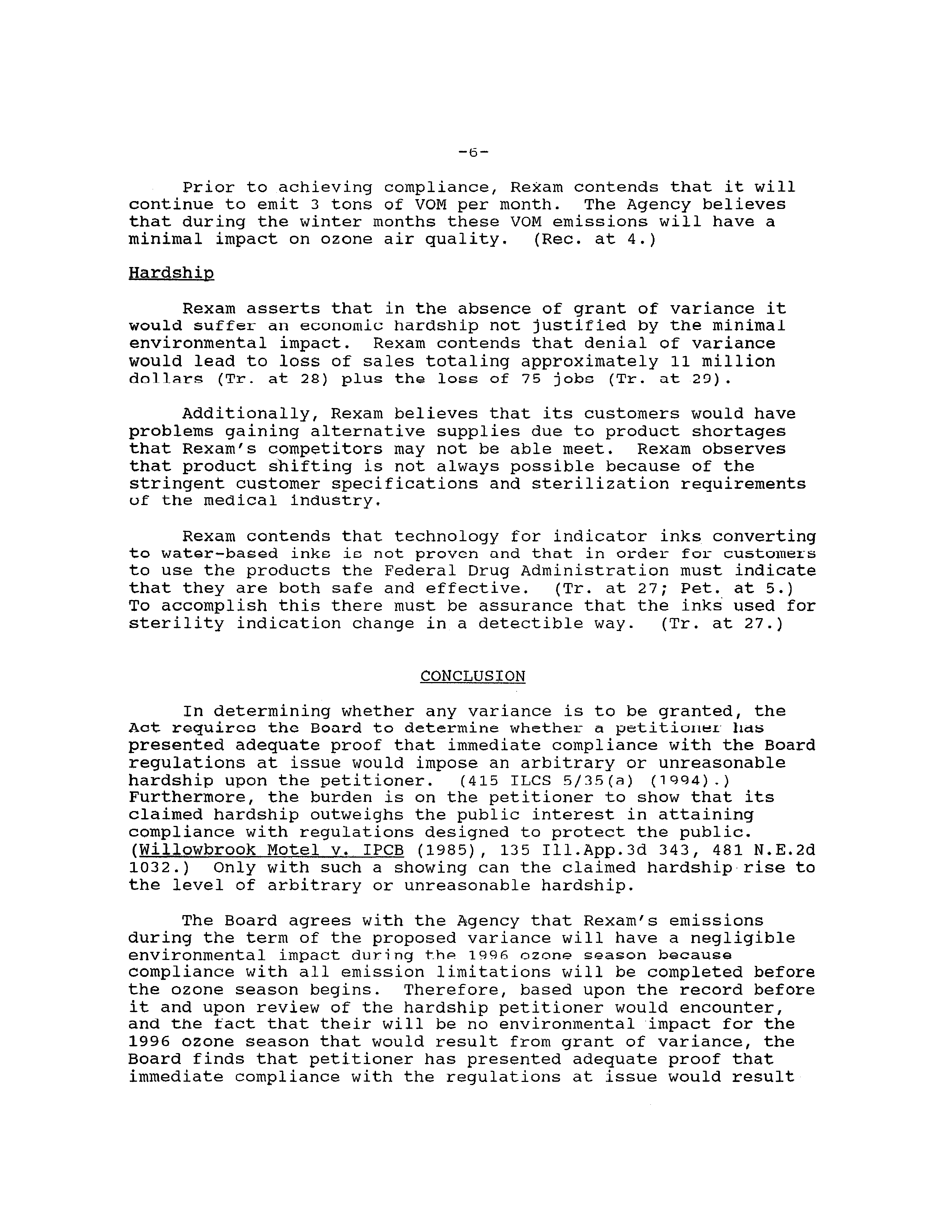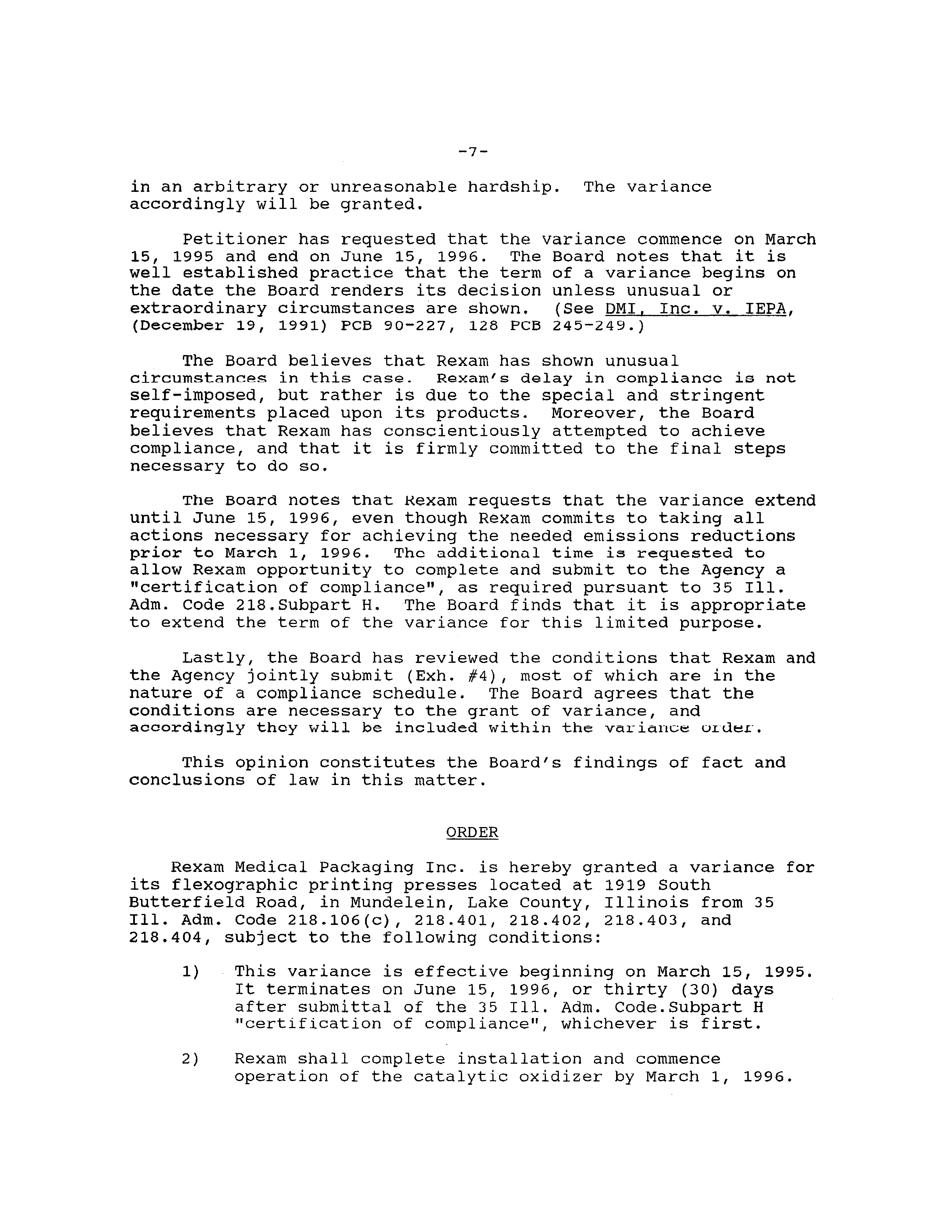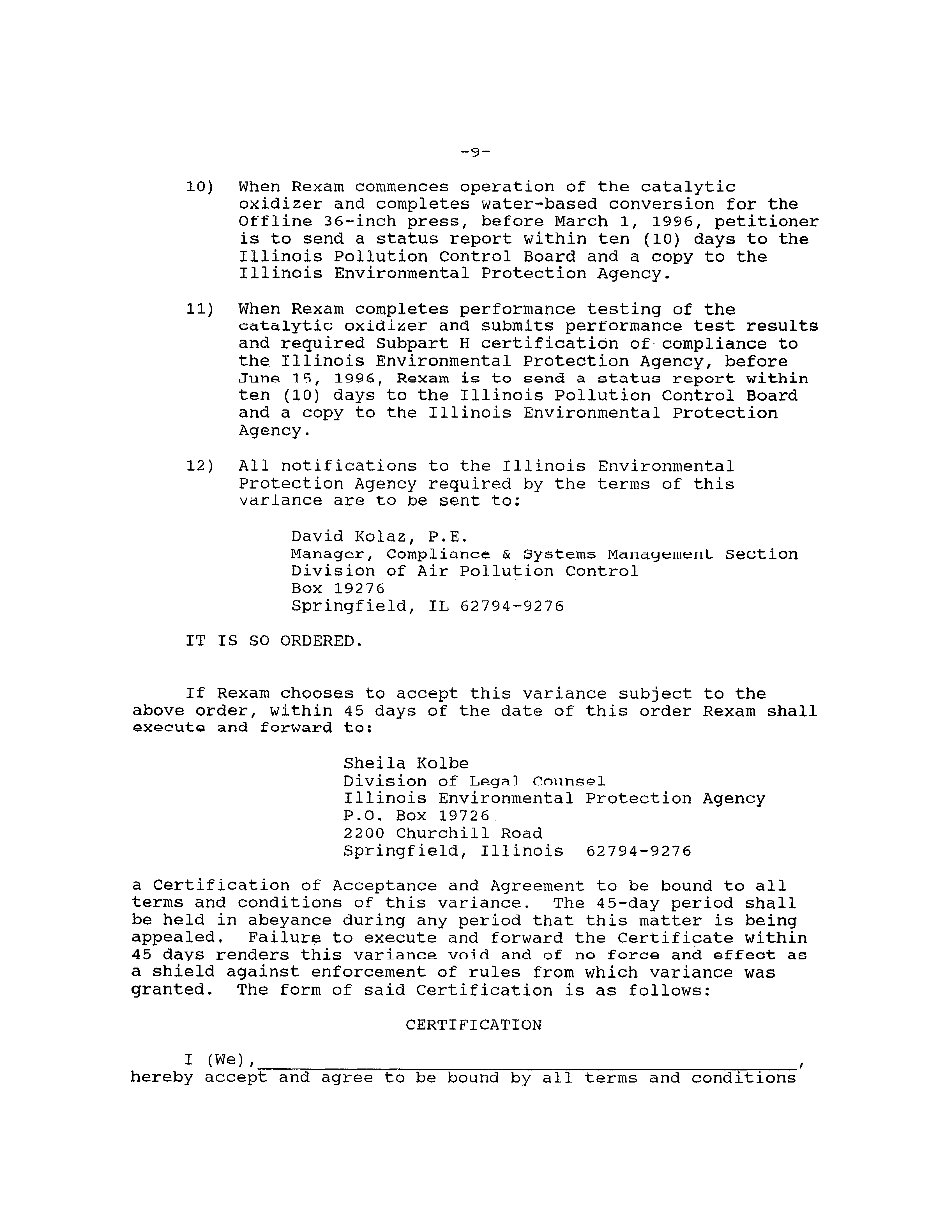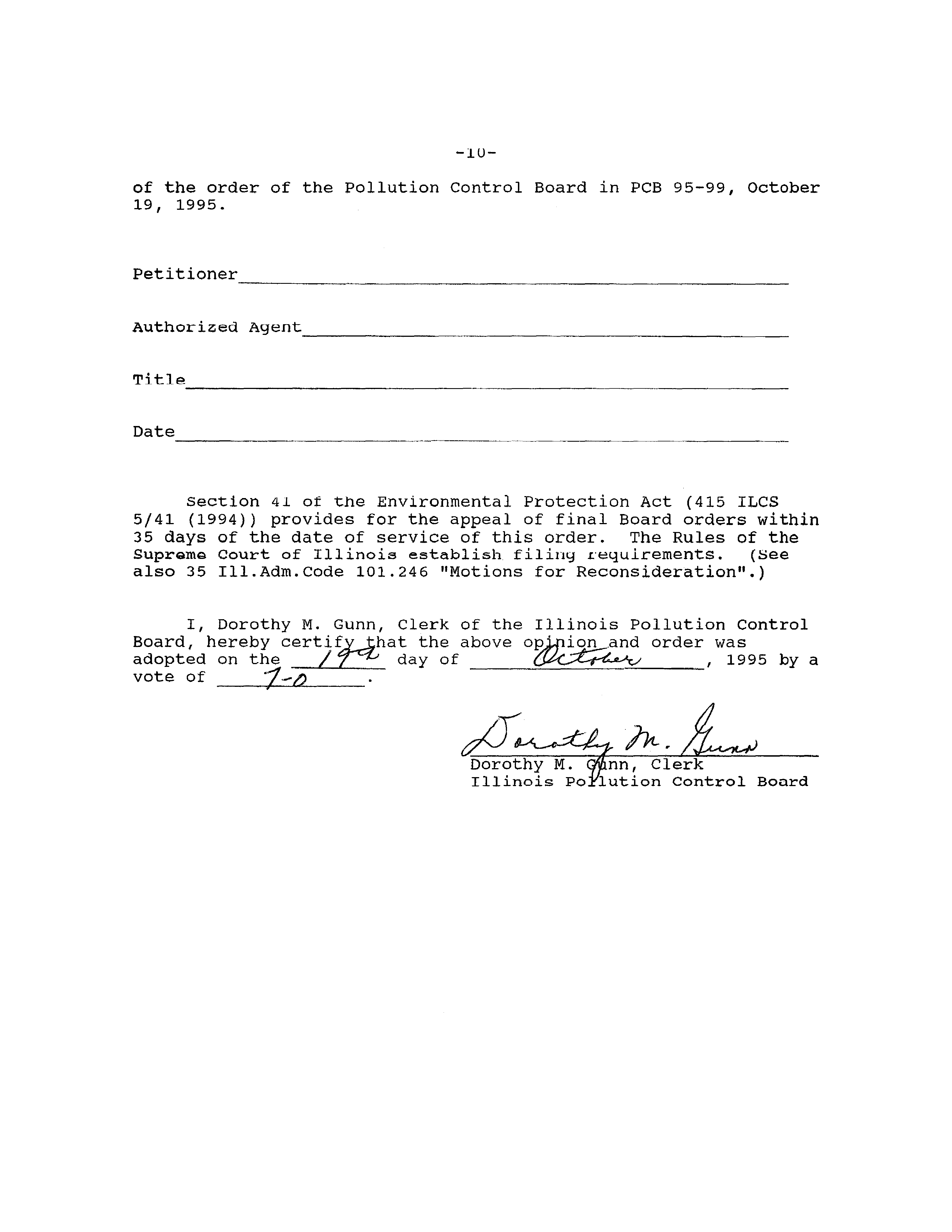ILLINOIS POLLUTION CONTROL BOARD
October
19,
1995
REXAN MEDICAL PACKAGING
)
INC.
(formerly DRG
)
MEDICAL PACKAGING INC.),
)
Petitioner,
PLb 95—~9
v.
)
(Variance-Air)
ILLINOIS ENVIRONMENTAL
)
PROTECTION AGENCY,
)
Respondent.
TIMOTHY J.
RACHKE, APPEARED ON BEHALF OF PETITIONER;
SHEILA G.
KOLBE APPEARED ON BEHALF OF THE RESPONDENT.
OPINION AND ORDER OF THE BOARD
(by R.
C.
Flomal):
This matter
comes
before the Board upon
a petition for
variance filed by Rexam Medical Packaging
Inc.
(Rexam)’.
Rexain
requests variance from certain control requirements applicable to
emissions of volatile organic material
(VOM)
from Rexam’s
flexographic printing presses located
at 1919 South Butterfield
Road,
in Mundelein,
Lake County,
Illinois.
Rexam. is requesting
that the term of the variance be from March
15,
1995 until June
15,
1996.
The Board’s responsibility
in this matter arises from the
Environmental Protection Act
(Act)
(415 ILCS 5/35
(1994)).
The
Board is charged there with the responsibility
of granting
variance from Board regulations whenever
it is found that
compliance with the regulations would impose an arbitrary or
unreasonable hardship upon the petitioner.
(415 ILCS 5/35(a)
(1994).)
The Agency
is required to appear
in hearings on
variance petitions.
(415 ILCS 5/4(f)
(1994).)
The Agency
is
also charged,
among other matters, with the responsibility of
investigating each variance petition and making
a recommendation
to the Board
as to the disposition of the petition.
(415 ILCS
5/37(a)
(1994).)
At hearing
on August
18,
1995,
petitioner filed
a
“Name
Change Form”
as Exhibit #5 indicating that DRG Medical Packaging
Inc. had changed
its name to Rexam Medical Packaging
Inc.
The
Board has changed the caption
in this proceeding
to reflect the
change.
Petitioner herein will be referred to as Rexam.
—2—
As presented below, the Board finds that Rexam has met its
burden of demonstrating that immediate compliance with the Act or
Board regulations at issue would result in an arbitrary or
unreasonable hardship.
Accordingly, the variance request will be
granted, subject to certain conditions.
PROCEDURAL HISTORY
Rexam filed the petition in this matter with the Board on
March 14,
1995.
Rexam requests variance from Board regulations
requiring floxographic printing
operations,
for which there
ic
potential to emit 25 tons per year
(TPY)
or more of VOM,
to
employ reasonably available control technology
(RACT)
on or
before March
15,
1995.
The regulations are found at 35 Iii. Adm.
Code 2l8.Subpart
H,
consisting
of Sections 218.401 through
218.4042; the compliance date
is separately found at
35 Iii. Adm.
Code 218.106(c).
Pursuant to 35
Iii. Adm. Code 104.180(a), the Agency’s
statutory recommendation was originally due on April 29,
1995.
On April
12,
1995,
the Agency filed
a motion
for
extension of
time to file the recommendation seeking an extension until May
15,
1995, which the Board granted on April
20,
1995.
On May 17,
1995, the Agency filed a second motion for extension of time
seeking an extension until July 17,
1995.
The Board granted this
motion on May 25,
1995.
On July 17,
1995,
the Agency filed its recommendation,
wherein
it recommends that the variance be granted subject to
certain conditions.
Rexam and the Agency subsequently submitted
a
revised
set of conditions
(see Exh.
#4)
which they contend are
appropriate
if the variance is to be granted.
(Tr.
at
6, 38.)~
A h~aring w~s
h~1don August
18,
1995
in Libertyville,
Illinois before Board hearing officer June Edvenson.
In addition
to testimony,
the parties entered six exhibits
.
The parties
waived their right to submit briefs.
2
Subpart H includes regulations applicable
to printing and
publishing generally.
Only the cited sections pertain to
flexographic printing operations.
~The transcript will be cited as
(Tr.
at
); the petition
will cited as
(Pet.
at
);
the Agency recommendation will be
cited as
(Rec.
at
)y and Exhibits will be cited as
(Exh.
#).
—3—
STATUTORY
FRAMEWORK
In determining whether any variance is to be granted,
the
Act requires the Board to determine whether a petitioner has
presented adequate proof that immediate compliance with the Board
regulation at issue would pose an arbitrary or unreasonable
hardship.
(415 ILCS 5/35 (a)
(1994).)
Furthermore, the burden is
on petitioner th show that its claimed hardship outweighs the
public interest in attaining immediate compliance with
regulations designed to protect the public.
(Willowbrook Motel
V.
Pollution Control Board
(1st Dist.
1977), 135 I1l.App.3d
343,
481 N.E.2d 1032).
only with such a showing can the claimed
hardship rise to the level of arbitrary or unreasonable hardship.
(We Shred
It,
Inc.
v.
Illinois Environmental Protection Agency,
(November
18,
1993), PCB 92-180 slip op.
at 3)
A further feature of a variance is that
it is,
by its
nature, a temporary reprieve from compliance with the Board’s
regulations, and compliance
is to be sought regardless of the
hardship which the task of eventual compliance presents an
individual polluter.
(Monsanto Co.
v.
Pollution Control Board,
(1977),
67 Ill.2d 276,
367 N.E.2d 634.)
Accordingly,
except in
certain special circumstances,
a variance petitioner
is required
as a condition to the grant of
a variance,
to commit to
a plan
which is reasonably calculated to achieve compliance within the
term of the variance.
The regulations that are the subject of the instant variance
request were adopted by the Board in 1994
in docket R93-14.
(~
the Matter of:
Reasonably Available Control Technology for Malor
Sources Emitting Volatile Organic Materials
in the Chicago Ozone
Nonattairiment Area:
25 Tons
(Amendments to 35
Ill.
Adm. Code
Parts 211 and 218),
(January
6,
1994).)
The purpose of limiting
VOM emissions is to reduce the quantity of ozone in the lower
atmosphere.
Ozone is a significant air pollutant that forms
through interactions of VOM with sunlight and oxygen,
particularly during the warm weather months.
BACKGROUND
Rexam manufactures sterilizable flexible packaging and film
products such as bags,
pouches,
and rollstock for sterilization
protection of medical devices and products.
The products are
sd
c3
to
‘med
ical
provi
dsrs
and
ars
dss
Igned to be
used
i
n
sterilization processes.
(Pet.
at
3;
Pr.
at
12.)
The packaging products contain printing,
such as
instructions on how to use the package and the type of product
the package may hold.
(Exh.
#3 at 4.)
Among special
requirements are that the inks used in the printing process
—4—
adhere to the packaging in order to prevent contamination of the
medical device product.
(Id.)
Among other unusual features is the need for special
inks
used as sterilization indicators.
Rexam’s products go through a
sterilization procedure to insure that they are contamination—
free.
(Tr. at
13.)
The indicator ink for sterilization consists
of a dual purpose ink which changes color to show that
sterilization has
occurred.
Thus,
a medical professional
can
verify by looking at the package that the products in the package
have been sterilized.
(Exh.
#3 at
4.)
Rexam also sterilizes re-
usable medical equipment that
is placed
in the pouches.
(Tr.
at
14.)
VOM emissions result from the vaporization of solvents used
in the printing process and,
to a lesser degree,
in cleaning the
printing presses.
(Pet.
at 3.)
The VOM discharge points are the
plant’s dryer exhaust stacks and the general building exhaust
ventilated
into the atmosplieLe.
(Id.)
Rexain’s total current VON
emissions are estimated to be
36 TPY.
(Rec.
at
3.)
Most
of
Rexam’s printing operations are presently in
compliance with the pertinent
RACT
regulations.
However,
six of
Rexam’s presses remain out of compliance.
Rexam requests the
instant variance to allow it to continue operations on these
presses while
it completes its
RACT
compliance
obligations.
DISCUSSION
Compliance
Status
Rexani began searching for compliance methods,
including the
use of lower VOM inks,
in
1990.
(Tr.
at 19.)
The company
undertook its first conversion to low-VOM inks in 1991 when it
replaced 40
VON ink with 3.5
VOM ink for part of its product
line.
(Id.)
In addition,
in late 1991 and early 1992 the
company began looking at water-based systems for roll film
processing.
(Id.)
Changing
to
a water-based system in this area
required
a new process and the company changed
its anilox rollers
used to transfer the ink onto the imaging plate and onto the film
from chrome to ceramic.
(Tr.
at
20.)
Rexam also changed its
fountain roll system and pumps for use in a water—based system.
During 1993 the company experimented with the new system and by
the end of 1994
it had ten extrusion lines converted to water-
based systems.
(Tr.
at 20-21.)
From 1990 to the date of the
hearing,
the company has spent a little over one
million dollars
to convert to low-VOM inks and to purchase control devices.
(Tr.
at 22.)
By March of
1995,
thirteen of Rexam’s presses had been
converted to water—based inks in compliance with Section
—5-
218.401(a).
(Pr.
at 24.)
However, five other flexographic
presses could not reach compliance by March 15,
1995 because they
were awaiting final customer product approval prior to conversion
to water-based indicator inks.
RexanL contends that customer product approval requires a
lengthy validation and testing trial period.
(Tr.
at 24.)
Nevertheless, No. 107 has now been converted and off-line 36 inch
press will be converted by December 1995.
(Tr.
at
25.)
The
proposed catalytic oxidizer for presses running solvent-based
indicator inks will complete the compliance program.
(Tr.
at
25.)
Compliance Plan
Rexam proposes to achieve compliance principally through the
installation and use of a catalytic oxidizer to control emissions
from four of
its presses
(press No.
105,
press No.
ill, of fline
32-inch press,
dud
ofline 42-inch press),
and the conversion the
fifth press
(offline 36-inch press)
to water-based ink.
Rexain
additionally commits to connecting the fifth press to the
n~i.dizer
if that press
is not converted to water-based
ink
by
March
1,
1996.
The Agency and Rexamn estimate the cost of the control
equipment at $277,991,
excluding taxes,
freight, hood capture
system,
installation cost,
special temperature monitors,
performance testing, environmental consulting,
and permitting
fees,
or any other additional costs.
(Rec.
at
5
and Pet.
at
7.)
Environmental Impact and Compliance with Federal Law
Rexam’s compliance program should allow Rexam to reduce its
VOM emissions to below
25 TPY,
as required by regulation.
Moreover, because the program is to be completed prior
to
the
beginning of the
1996 warm weather months,
both Rexant and the
Agency contend that grant of variance would have no effect on
ozone levels during the coming and future ozone seasons4.
(Tr.
at 37.)
The Agency also observes that, because the control equipment
will be installed by the 1996 ozone season,
the granting of the
variance will not impede the State’s efforts
in achieving the 15
reduction in VOM emissions required by Section 182(b) (1) of the
Clean Air Act
(42 U.S.C.
7511
(b)(1)).
(Rec. at
E.)
~ The ozone season is the annual period from April
1 to
October 31.
—6—
Prior to achieving compliance, Rexam contends that it will
continue to emit
3 tons of VOM per month.
The Agency believes
that during the winter months these VOM emissions will have a
minimal impact on ozone air quality.
(Rec.
at
4.)
Hardship
Rexam asserts that
in the absence of grant of variance it
would suffer
an
economic hardship not justified by the minimal
environmental impact.
Rexam contends that denial of variance
would lead to loss of sales totaling approximately 11 million
dollars
(Pr.
at 22) plus the
loss of
75 jobs
(Tr.
at
29).
Additionally, Rexam believes that its customers would have
problems gaining alternative supplies due to product shortages
that Rexant’s competitors may not be able meet.
Rexam observes
that product shifting is not always possible because of the
stringent customer specifications and sterilization requirements
of
the medical Industry,
Rexam contends that technology for indicator inks converting
to water—based
inks is not proven and that
in order for
customers
to use the products the Federal Drug Administration must indicate
that they are both safe and effective.
(Tr.
at 27; Pet.
at
5.)
To accomplish this there must be assurance that the inks used for
sterility indication change in a detectible way.
(Tr.
at 27.)
CONCLUSION
In determining whether any variance is to be granted, the
Act requires the Board
to determine whether
a
petitioui~L
has
presented adequate proof that immediate compliance with the Board
regulations at issue would impose an arbitrary or unreasonable
hardship upon the petitioner.
(415 ILCS
5/35(a)
(1c394).)
Furthermore, the burden is on the petitioner to show that its
claimed hardship outweighs the public interest in attaining
compliance with regulations designed to protect the public.
(Willowbrook Motel v.
IPCB
(1985),
135 Ill.App.3d 343,
481 N.E.2d
1032.)
Only with such a showing can the claimed hardship rise to
the level of arbitrary or unreasonable hardship.
The Board agrees with the Agency that Rexam’s emissions
during the term of the proposed variance will have
a negligible
environmental impact during
the
1995 ozone
season
because
compliance with all emission limitations will be completed before
the ozone season begins.
Therefore,
based upon the record before
it and upon review of the hardship petitioner would encounter,
and the tact that their will be no environmental impact for the
1996 ozone season that would result from grant of variance, the
Board finds that petitioner has presented adequate proof that
immediate compliance with the regulations at issue would result
—7—
in an arbitrary or unreasonable hardship.
The variance
accordingly will be granted.
Petitioner has requested that the variance commence on March
15,
1995 and end on June 15,
1996.
The Board notes that it is
well established practice that the term of a variance begins on
the date the Board renders its decision unless unusual or
extraordinary circumstances are shown.
(See DM1.
Inc.
V.
IEPA,
(December 19,
1991)
PCB 90—227,
128 PCI3 245—249.)
The Board believes that Rexam has shown unusual
circumstances
in this
case.
Rexam’s
delay
in compliance
is not
self-imposed, but rather is due to the special and stringent
requirements placed upon its products.
Moreover, the Board
believes that Rexam has conscientiously attempted to achieve
compliance, and that
it
is firmly committed to the final steps
necessary to do so.
The Board notes that k~examrequests that the variance extend
until June
15,
1996,
even though Rexam commits to taking all
actions necessary for achieving the needed emissions reductions
prior to March
1,
1996.
The additional
time
is requested to
allow Rexam opportunity to complete and submit to the Agency a
“certification of compliance”,
as required pursuant to 35 Iii.
Adni.
Code 218.Subpart
H.
The Board finds that it is appropriate
to extend the term of the variance for this limited purpose.
Lastly, the Board has reviewed the conditions that Rexam and
the Agency jointly submit
(Exh.
#4),
most of which are in the
nature of
a compliance schedule.
The Board agrees that the
conditions are necessary to the grant of variance, and
accordingly they will be included within the
variance ULdei.
This opinion constitutes the Board’s findings of fact and
conclusions of law in this matter.
ORDER
Rexam Medical Packaging Inc.
is hereby granted a variance for
its flexographic printing presses located at 1919 South
Butterfield Road,
in Mundelein,
Lake County, Illinois from 35
Ill.
Adni.
Code 218.106(c), 218.401,
218.402, 218.403,
and
218.404, subject to the following conditions:
1)
.
This variance is effective beginning
on March
15,
1995.
It terminates on June
15,
1996,
or
thirty
(30)
days
after submittal of the 35
Ill.
Adm.
Code.Subpart H
“certification of compliance”,
whichever
is first.
2)
Rexam shall complete installation and commence
operation of the catalytic oxidizer
by March
1,
1996.
—8—
Flexographic printing lines controlled by the catalytic
oxidizer must include Press No.
105, Press No.
111,
Offline 32-inch press,
and the new Offline 42-inch
press.
3)
Rexam shall complete performance testing of the
catalytic oxidizer by April
15,
1996.
Performance
testing must include determination of the VOM reduction
efficiency capture system and control equipment
Rexam shall submit results of the performance testing
to the Illinois Environmental Protection Agency by June
15,
1996.
4)
Rexam shall complete water—based ink conversion
for the
flexographic printing Offline 36-inch press by March
1,
1996.
If the line is not converted by this date,
it
must be connected to the catalytic oxidizer by March
1,
1996.
5)
Rexam shall submit to the Illinois Environmental
Protection Agency
a “certification of compliancett with
35 Ill. Adm. Codc.E~ubpart
II regulations required
pursuant to Section 218.404 by June
15,
1996,
6)
Upon receipt of the construction permit for the
catalytic oxidizer, Rexam shall send quarterly status
reports to the Illinois Environmental Protection Agency
on the progress of the installation and testing. of the
control equipment,
with the following information:
a.
Dates when installation begins and ends;
b.
Test results; and
C.
Any correspondence
from the control equipment
manufacturer
indicating pending delay.
7)
Rexam shall notify the Illinois Environmental
Protection Agency that physical installation of the
catalytic oxidizer is complete within ten
(10) days of
the completion
date.
8)
Rexam shall notify the Illinois Environmental
Protection Agency when full-time operation of the
catalytic oxidizer ha~rommenced within
ten
(10)
dcty3
of control equipment start up date.
9)
Rexam shall notify the Illinois Environmental
Protection Agency that conversion to water-based ink
for the flexographic printing Offline 36—inch press
is
complete within ten
(10)
days of completion date of
such conversion.
—9—
10)
When
Rexain commences operation of the catalytic
oxidizer and completes water-based conversion for the
Offline 36—inch press,
before March
1,
1996, petitioner
is to send
a status report within ten
(10) days to the
Illinois Pollution Control Board and a copy to the
Illinois Environmental Protection Agency.
11)
When Rexam completes performance testing of the
catalytic oxidizer and submits pertormance test results
and required Subpart H certification of compliance to
the Illinois Environmental Protection Agency, before
June
15,
1996,
Rexam is
to send
a status report within
ten
(10) days to the Illinois Pollution Control Board
and a copy to the Illinois Environmental Protection
Agency.
12)
All notifications to the Illinois Environmental
Protection Agency required by the terms of this
variance are
to be sent
to;
David Kolaz,
P.E.
Manager, Compliance
&
3ystems ManageiueiiL Section
Division of Air Pollution Control
Box 19276
Springfield,
IL 62794—9276
IT IS SO ORDERED.
If Rexam chooses
to accept this variance subject
to the
above order, within 45 days
of the date of this order Rexam
shall
execute and forward to:
Sheila Kolbe
Division of Legal
Counsel
Illinois Environmental Protection Agency
P.O.
Box 19726
2200 Churchill Road
Springfield,
Illinois
62794—9276
a Certification of Acceptance and Agreement to be bound to all
terms and conditions of this variance.
The 45-day period shall
be held in abeyance during any period that this matter is being
appealed.
Failure to execute and forward the Certificate within
45
days renders this variance
vnii
and
of no force and effect
as
a shield against enforcement of rules from which variance was
granted.
The form of said Certification is as
follows:
CERTIFICATION
I
(We),
hereby accept and agree to be bound by all terms and conditions
—‘U—
of the order of the
Pollution Control Board in PCB 95-99,
October
19,
1995.
Petitioner___________ ___________________________________________
Authorized Agent_______________ ______________________________
Title
Date____________
_________
____
_____
_______________
Section
41
ot
the Environmental Protection Act
(415 ILCS
5/41
(1994))
provides for the appeal
of final Board orders
within
35 days of the date of service of this order.
The Rules of the
Supreme Court
of
Illinois establish, filing requirements.
(See
also 35 Ill.Adm.Code
101.246 “Motions for Reconsideration”.)
I,
Dorothy
N.
Gunn,
Clerk of the Illinois Pollution Control
Board, hereby certifL~hatthe above opjpion and order was
adopted on the
/7’~’-’
day of
___________________,
1995 by a
voteof
7.-,~
.
Dorothy M. ~nn,
Clerk
Illinois Po~’lutionControl Board
